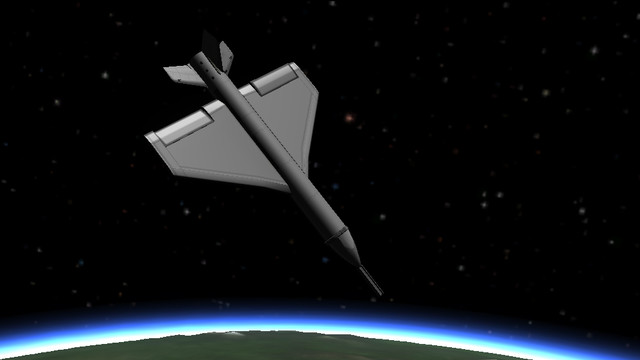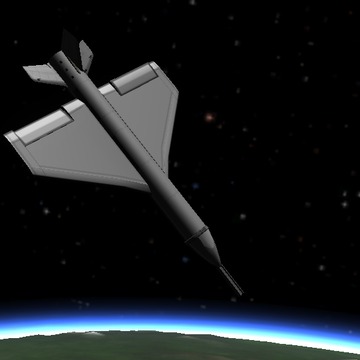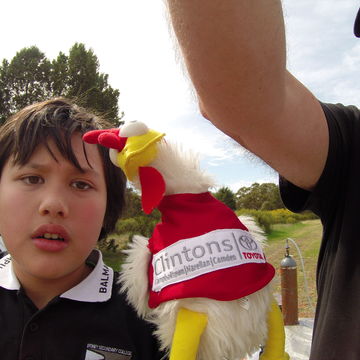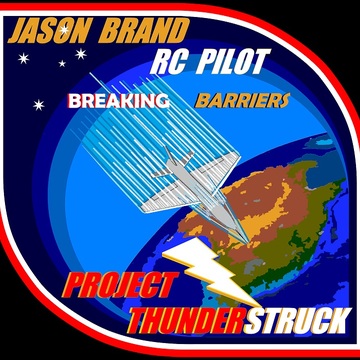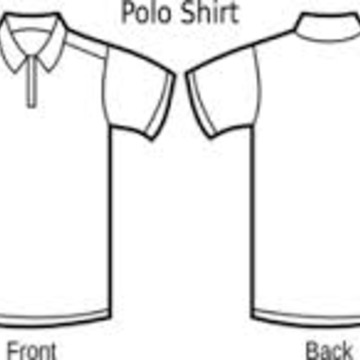Robert Brand hasn't added a story.
Project ThunderStruck set to Break Barriers
by Robert Brand
This project is two projects in one. The total aim of ThunderStruck is to build as small a space craft as possible that will handle reentry, remain stable and land softly. The "softly" is important as commercially there are payloads that may need to be conducted in a "weightless" environment and then be brought down without too much jarring. A parachute landing will not be suitable. My son who is very aerospace savvy was keen to be involved in some way and Project ThunderStruck was born. We will help do the low altitude testing - when I say low, i mean from 40Km altitude (25 miles)
Imagine a time when a 12 year student could design and build a supersonic glider 2.5m / 8ft long, attach it to a huge helium or hydrogen balloon and take it to the edge of space, release it, fly it into a dive back to earth that will reach Mach 1.5 / 1,800kph / 1,120mph and land it. Well that time is now and the student is Jason Brand from Sydney Secondary College / Balmain Campus. He is in year 7 and has already broken plenty of records with his hobbies. Breaking the sound barrier will be another cool record.
New Science, New Data, New Opportunities
Apart from the glitz of the big event in 6 months (a 12-year-old breaking the sound barrier) there is a lot of science being done. In fact the event side of this project will be funded by sponsors and the crowd funding will be for the additional science outlined below.
There is a commercial opportunity to design and create a winged re-entry vehicle specifically for delicate payloads and experiments that last for more than 4 minutes in a weightless environment (tourist sounding flights to space). These are experiments and payloads that would find a parachute landing too harsh. There is a final output of the work and that is a spacecraft for experiments or even a payload taxi service back to earth. The most important aspect of this work is determining the smallest size of a winged spacecraft that can remain stable during re-entry. There are three stages of the physical testing:
- Transonic - Project ThunderStruck in 6 months time
- Reentry from space (delivered on a sounding rocket - no orbit); 2-3 years away.
- Re-entry from orbit; 6 years away
There are two science components to the upcoming testing over the next 6 months:
- Stability of a small aircraft at mach 1.5 / 1,800kph / 1,120mph and lower speeds for landing
- testing a new type of surface for high-speed flight. (not a heat shield)
Since Jason has experience and a fantastic track record in High Altitude Balloon flights and flying remote control aircraft, he wanted to look after that first phase of the project. The transonic Phase. Transonic flight is the flight around the area of breaking the sound barrier. All sorts of problems occur near the sound barrier. When we drop the aircraft from 40Km altitude, first we have to get through the sound barrier as the drag increases significantly, but once through the barrier, the drag essentially reduces until your speed increases further. The real testing then commences as our tests will be about slowing, not increasing speed. We will be measuring the behaviour of the craft and airflow over the surfaces.
Project ThunderStruck has Commenced Flying Tests
Just in case you are concerned that this is all talk and no action, we started test flights in Sept 2014. The results are simply amazing and we will use them to refine our project.
The event will take 6 to 9 months to complete and the testing is the most important aspect of this project. It is new territory for us and almost the entire world. There is still fresh science to be done and innovative ways to use new materials and designs. Recently we learned a lot when a non-aerodynamic payload (space chicken from Clintons Toyota) reached speeds of 400kph / 250mph with its parachute deployed. This is because the air is pretty thin up at 33.33Km or 1/3 the way to space. Our payload took several measurements during the fall.
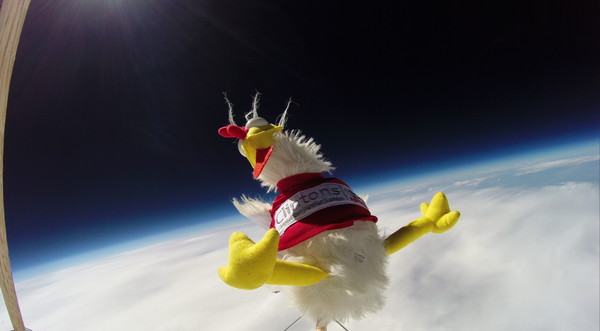
The space chicken was a simple test and we are now happy that we can easily fly at speeds of Mach 1.5 in the very thin air high up in the stratosphere. Left is a picture of the chicken falling back to earth at 400kph. Even the parachute could not slow the payload in the thin air. It slowed down as it reached 28Kms altitude and the air got a bit thicker.
We have started fund raising as we need help to cover the costs of the science parts of the project. Once we know what we have, we can decide on the extent of the program. We need $20,000 or more just for science and we have turned to crowd funding for that.
We have some “Perks” as part of crowd funding that I hope you will love. Some of our payloads will go supersonic before the big event, but they will not be aircraft. We might even donate one of our supersonic payloads to a generous contributor.
STEM - Project ThunderStruck set to Inspire Kids Worldwide.
Fighter jets break the sound barrier every day, but this radio controlled aircraft has no engine, weighs 9Kg (20lbs), is 2.5m (8 ft) long. So the pilot must be a really experience Top Gun to fly this plane at 1,800kph (1,120mph)? Well, no. His name is Jason Brand and he is 12 years old.
This is probably one of the most important demonstrations of STEM education that you can support. This is beyond the ability of almost every adult on the planet, yet a 12 year old student is set to inspire kids around the world with a daring project that is pure STEM – Science Technology Engineering Mathematics. It will make the seemingly impossible the domain of the young if they choose to break down the barriers imposed by themselves or others. Not only that, there is real science going on here.
Your Assistance is Essential
Your crowd funding help now is essential. It gets us started immediately. Flying balloons to the edge of space for testing is an expensive exercise and we have a 7 hour drive each way to get into areas of low air traffic away from the major aircraft trunk routes. We also have to buy a lot of radio systems to allow remote control from the ground when the glider is up to 100kms distance.
You can click on one of the 2 crowd funding links at the top right of the page. Even $1 will help unlock new discoveries and bed down older science.
Who is Jason Brand?
He is a 12 y/o student from Sydney Secondary College, Balmain Campus in Sydney, Australia.
He carried out his first High Altitude Balloon (HAB) project at age 9 and was so inspired that he sat for his amateur radio license at 9 years old. Since then he has launched a total of 19 HAB flights and recovered all 19. Some flights were in Croatia where mountains, swamps and landmines are risks not seen in Australia. He is also the Student Representative for Team Stellar – A Google Lunar X-Prize team attempting to get a rover onto the moon.
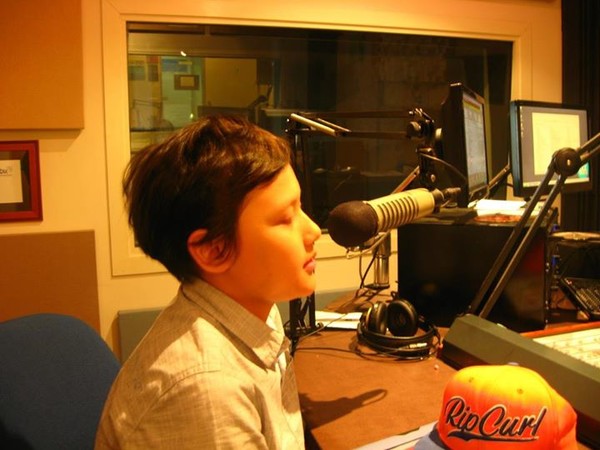
Jason appears on Radio and TV regularly and the picture above shows him talking about HAB flights on Canberra’s Fuzzy Logic Science Show in 2013. He is also a member of the Australian Air League, Riverwood Squadron. He plans to solo on his 15th birthday.
His father Robert Brand is an innovator in creating low cost solutions for spaceflight. He speaks regularly at international conferences, is a regular guest lecturer on aerospace at Sydney University, writes about aerospace and takes a very “hands on” approach to space. He supports Jason’s project fully.
How will ThunderStruck work?
The same way that the first pilots broke the sound barrier: in a steep dive. The problem is that since there is no engine and the biggest issue is air resistance, Jason will launch the aircraft from over 40km altitude or nearly half way to space! He will get it there on a high altitude balloon. The air is very thin at that altitude and the craft should accelerate past the speed of sound before it is thick enough to slow it down. A tiny fraction of one percent of the air at sea level. During the dive, the craft will accelerate to well over Mach 1 and way less than Mach 2 and will need to be controllable by its normal control surfaces to pass as an aircraft. As the air thickens at low altitudes, the craft will slow and with the application of air brakes will slow and then be levelel off for normal flight to the ground.
The Technology
We will have a camera in the nose of the aircraft and it will transmit TV images to the pilot on the ground. Jason will be either in a darkened room with a monitor or wearing goggles allowing him to see the view from the on-board camera. This provides what is known as First-person Point of View (FPV). The aircrafts instruments will be overlaid on the video signal. This is known as “On Screen Display” or OSD. Below is a view typical of what will be seen by Jason as he lands the craft.
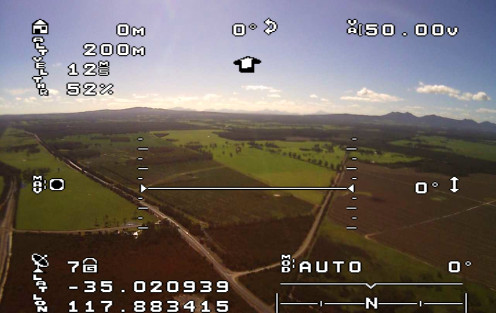
The video signal must travel over 100kms to be assured of the craft being in the radius of the equipments limits. Similarly we must send commands to the control surfaces of the radio controlled aircraft. Again this must work at a distance of over 100kms. The craft has ailerons, elevators and rudder as well as air-breaks and other systems that need controlling. We will use a 10 channel system to ensure that we have full control of every aspect of the craft and a "binding" system will ensure that only we can fly the aircraft.
We will have to buy 2 x $5,000 GPS unit capable of sampling at what is essentially the speed of a missile. These are highly restricted items, but essential. The unit will record to an SD card and send back telemetry every second. It is essential to know the speed during the flight rather than waiting until after the event. After all Jason needs to knowthe speed to be able to fly the aircraft. We will also need 2 x radar responders to allow other aircraft and air traffic controllers to know where our craft is and our balloon is at any time.
The Big Event
We can expect global TV News coverage of the event and many records to be broken. The day will start by filling a large Zero Pressure Balloon like the one pictured below.
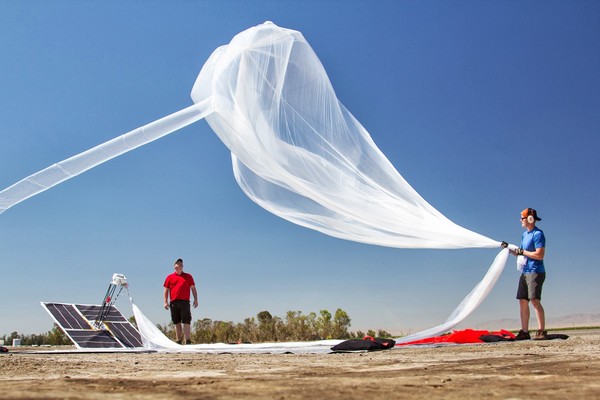
The balloon will carry the aircraft to over 40km where it will be released and go into a steep dive and break the sound barrier. As the air thickens, the speed will slow and the craft will be pulled out of the dive and leveled off to drop speed. The aircraft will eventually land and data and video records will be recovered. We will already know the top speed, but there is nothing like solid data rather than radio telemetry that may miss the odd data packet. Both the balloon and the aircraft will be transmitting live video.
There will be opportunities to attend, but it is likely to be in a rather remote part of the state (NSW, Australia) or a nearby state. The flight will be broadcast over the Internet and the opportunity to track and follow the flight will be available to all. The chance to be involved is high and the science and inspiration will be out of this world. Project ThunderStruck is set to thrill.
Visit our sister site wotzup.com for more space and balloon stories Featured
• Airframe • Balloons • Cost/Budget • Overview • Speed • Technology
Perks
- 0 claimed
You or your company's 15cm x 15cm (approx 6" x 6") logo or name on the fuselage of ThunderStruck. This aircraft will will be seen globally and pictures and video will be seen world wide for years to come. Be seen to support the flight and the first in will be able to claim the best place for logos of this size. We will even accept a portrait if it meets our standards. The logo will also appear on our website and you will receive a cap and tee shirt when they are available
- 0 claimed
- 5 remaining
You or your company's 30cm x 15cm ( approx 12" x 6") logo or name on the fuselage of ThunderStruck. This aircraft will will be seen globally and pictures and video will be seen world wide for years to come. Be seen to support the flight and the first in will be able to claim the best place for logos of this size. We will even accept a portrait if it meets our standards. The logo will also appear on our website and you will receive 2 x caps and 2 x tee shirts when they are available. The shape of the space can be negotiated, but it is 450 sq cm or approximately 70 sq inches
Highlights
See all activity17Activity
Help a 12 year old Break the Sound Barrier Community
Our community shows our leading supporters and the contributions they've made or inspired by sharing our campaign.
How it works
To appear in our community, simply make a contribution to our campaign
and show your name, or inspire a contribution from someone else by sharing your personal link (below).
The more contributions you make or inspire, the higher you'll go and the more the campaign will benefit.
How it works
To appear in our community, simply make a contribution to our campaign
and show your name, or inspire a contribution from someone else by sharing your personal link (below).
The more contributions you make or inspire, the higher you'll go and the more the campaign will benefit.
Here's your personal link to share:
Copy- 0 claimed
You or your company's 15cm x 15cm (approx 6" x 6") logo or name on the fuselage of ThunderStruck. This aircraft will will be seen globally and pictures and video will be seen world wide for years to come. Be seen to support the flight and the first in will be able to claim the best place for logos of this size. We will even accept a portrait if it meets our standards. The logo will also appear on our website and you will receive a cap and tee shirt when they are available
- 0 claimed
- 5 remaining
You or your company's 30cm x 15cm ( approx 12" x 6") logo or name on the fuselage of ThunderStruck. This aircraft will will be seen globally and pictures and video will be seen world wide for years to come. Be seen to support the flight and the first in will be able to claim the best place for logos of this size. We will even accept a portrait if it meets our standards. The logo will also appear on our website and you will receive 2 x caps and 2 x tee shirts when they are available. The shape of the space can be negotiated, but it is 450 sq cm or approximately 70 sq inches
Set as ?
The campaign video will appear in social media and email.
The campaign cover picture will appear in social media and email.
The will appear at the top of your campaign page and in social media and email.
Reset ?
It will be removed from the top of your campaign and won't be used as default in social media and email. The will remain in the media gallery.
Share
Embed
Share a link
Delete update
Delete this story update?
Any pictures or videos will remain in the campaign's media gallery.
Report campaign
Report submitted
Thank you. We take reports like yours very seriously. Our goal is to keep the community safe.
Please know that we may contact you for more information, but that we won't notify you personally of our decision. If the campaign remains available within a few days, it's likely that we determined it not to be in violation of our policies.
Thank you. We've already received your previous report. If the campaign remains available within a few days, it's likely that we determined it not to be in violation of our policies.
Tell us about the problem. Please fill in both fields below.
Record a video
Upload a video
Nothing grabs attention for your cause like a personal video. Take a minute or two to record one now. Record a short video message of support. Or upload one from your device. You can preview or redo your video before you post it.
Nothing grabs attention for your cause like a personal video. Upload a short video message of support. Upload a short video message of support. Or record one right now.
- Most effective video length: about a minute.
- Maximum length: 5 min.
- You can preview or redo your video before you post it.
Heads up! The existing video will be replaced.
Email your friends
Join our team
Your endorsement banner
Use your endorsement banner to tell why our cause matters to you. Such personal endorsements are proven to increase campaign contributions. When enabled, your endorsement banner appears at the top of the campaign for everyone who visits a link you shared.
You can always adjust your endorsement from the campaign Share page—even if it's been disabled.
Your message
Tell people why our cause matters to you. Your personal message will encourage others to help. Easy, effective, optional.
Say it in video
Short personal videos by supporters like you are incredibly powerful. Record one right now and you'll help us raise more money. Easy, optional, effective.
Add a personal goal
Set a personal fundraising goal. You'll encourage more contributions if you do. And rest easy. There's no obligation to achieve your goal or bad consequences if you don't. Easy, optional, effective.
We have a video!
Video thumbnail
We'd love to show you our campaign video. Want to take a look?
, you're already on the team.

